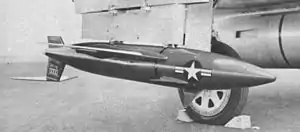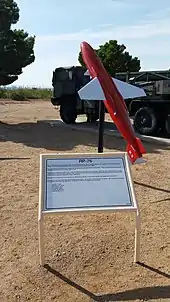Northrop AQM-38
The AQM-38 was an American target drone, developed during the 1950s by the Radioplane Division of the Northrop Corporation, Newbury Park, California, and manufactured by its Ventura Division at Van Nuys, California.[1] Extensively used for surface-to-air missile training, over two thousand were built during its production run and it saw continued use within the United States Army and United States Navy for nearly twenty years.
| AQM-38 | |
|---|---|
 AQM-38A on F-89 Scorpion launch aircraft | |
| Type | Target drone |
| Place of origin | United States |
| Service history | |
| In service | 1959-1970s |
| Used by | United States military |
| Production history | |
| Manufacturer | Northrop Corporation |
| No. built | 2000+ |
| Specifications (AQM-38A) | |
| Mass | 300 pounds (140 kg) |
| Length | 9 feet 8 inches (2.95 m) |
| Height | 1 foot 6 inches (0.46 m) |
| Diameter | 12 inches (300 mm) |
| Wingspan | 5 feet (1.5 m) |
| Engine | Aerojet 530NS35 36 lbf (160 N) |
| Propellant | Solid fuel |
| Flight ceiling | 60,000 feet (18,000 m) |
| Boost time | 9 minutes |
| Maximum speed | Mach 0.94 |
Launch platform | F-89 Scorpion |
Design and development

Following flight trials of the XKD4R target drone, developed for the United States Navy, Radioplane redesigned the aircraft into an improved version, designated RP-76, which first flew in 1959.[2] Compared to the XKD4R, the RP-76 had redesigned wing fairings, with the vertical control fin being moved to the underside of the missile, as opposed to being on top.[3]
The RP-76 was designed to fly a pre-programmed trajectory on autopilot, with radio command guidance being optional.[2] As with the XKD4R, control was provided by three fins located forwards on the body of the craft. A Luneburg lens was included to augment the drone's radar signature, and recovery at the end of the flight was by parachute.[2]
Operational history
Following its first flight in 1959,[3] the RP-76 was most often launched from a F-89 Scorpion fighter of the United States Air Force, and was extensively used by the U.S. Army for training the operators of surface-to-air missiles;[2] it saw additional use in training USAF fighter pilots in air-to-air gunnery, as well.[4]
A slightly modified version, designated RP-78, was supplied to the U.S. Navy; it used a more powerful rocket, producing 99,000 lbf (440 kN) of thrust,[4] to propel the drone to a top speed of Mach 1.25.[2]
In 1963, the RP-76 and RP-78 received the designations AQM-38A and AQM-38, respectively, in the new "tri-service" missile designation system.[4] In all, over 2,000 examples of the drone were built by Northrop, with the missile remaining in service with the U.S. Military until they were retired in the mid-1970s.[2]
See also
References
- Citations
- Hearings on military posture and H.R. 13456, p. 7794.
- Parsch 2003a
- Parsch 2003b
- Jane's 1967, p.421.
- Bibliography
- Parsch, Andreas (2003a). "Northrop (Radioplane) AQM-38". Directory of U.S. Military Rockets and Missiles. designation-systems.net. Retrieved 2011-01-28.
- Parsch, Andreas (2003b). "Radioplane KD4R". Directory of U.S. Military Rockets and Missiles Appendix 1: Early Missiles and Drones. designation-systems.net. Retrieved 2011-01-28.
- Taylor, John W.R., ed. (1967). Jane's All The World's Aircraft 1967-1968. London: Jane's Information Group.
External links
![]() Media related to AQM-38 at Wikimedia Commons
Media related to AQM-38 at Wikimedia Commons